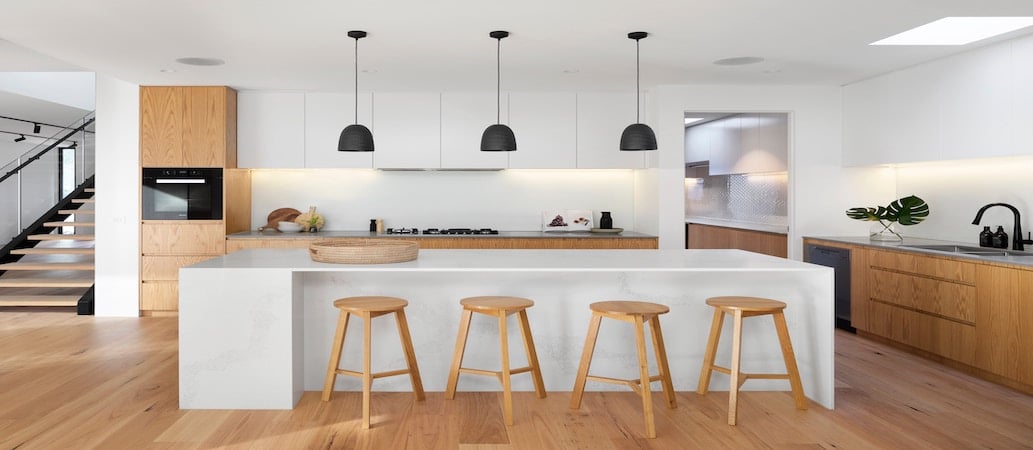A Comprehensive Guide
Embarking on a kitchen remodel is an exciting endeavor that can transform the heart of your home into a more functional, stylish, and enjoyable space. However, the process requires careful planning and consideration to avoid common pitfalls and ensure a successful outcome. Whether you’re looking to increase your kitchen’s functionality, update its aesthetics, or improve its layout, a well-thought-out plan is essential. This guide will walk you through the crucial steps in planning a kitchen remodel.

1. Define Your Remodeling Goals
Before diving into the details of your kitchen remodel, take the time to clearly define your goals. Ask yourself what you want to achieve with this renovation. Are you aiming to create more space? Do you need better storage solutions? Is updating the look and feel of the kitchen your primary objective? By establishing your goals upfront, you can make informed decisions throughout the remodeling process.
Understanding Your Needs vs. Wants
Differentiate between your needs and wants. Needs are essential for functionality and safety, such as replacing outdated appliances or improving ventilation. Wants, on the other hand, include aesthetic choices like a particular countertop material or a designer backsplash. Prioritizing needs over wants will help keep your project on track and within budget.
2. Set a Realistic Budget
Budgeting is a critical aspect of planning a kitchen remodel. It’s easy to get carried away with luxurious features and high-end materials, but it’s important to establish a realistic budget based on your financial situation. Research the costs associated with different aspects of kitchen remodeling, including labor, materials, and permits. Allocate a portion of your budget for unexpected expenses that may arise during the renovation.
Cost Breakdown
A typical kitchen remodel budget can be broken down into the following categories:
- Cabinetry and hardware: 30-40% of the budget
- Countertops: 10-15% of the budget
- Appliances: 15-20% of the budget
- Labor: 20-25% of the budget
- Flooring: 10-15% of the budget
- Lighting and fixtures: 5-10% of the budget
Finding Financing Options
If your budget exceeds your immediate funds, consider financing options such as home equity loans, personal loans, or credit lines. Research each option carefully to understand the interest rates, repayment terms, and any associated fees.
3. Develop a Functional Layout
The layout of your kitchen is a key factor in its overall functionality. An efficient kitchen layout should accommodate your cooking style, maximize space, and enhance the flow of movement. There are several popular kitchen layout configurations, each with its own advantages.
Explore Layout Options
- Galley Kitchen: Ideal for small spaces, the galley layout features two parallel countertops with a walkway in between. It maximizes storage and workspace while minimizing the need to move around excessively.
- L-Shaped Kitchen: This layout is perfect for open-concept homes. It includes two adjoining walls with countertops, offering ample workspace and flexibility.
- U-Shaped Kitchen: This layout is great for larger kitchens, providing plenty of counter space and storage along three walls. It creates a highly functional working triangle, which is ideal for cooking.
- Island Kitchen: Incorporating an island in the kitchen layout adds extra counter space, storage, and seating. Islands can serve as a prep area, cooking station, or casual dining spot.
The Importance of the Work Triangle
The work triangle concept involves placing the sink, stove, and refrigerator in a triangular layout to minimize unnecessary movement and create a more efficient workspace. Ensure that the sides of the triangle are not obstructed by foot traffic or barriers.
4. Choose Quality Materials and Finishes
Selecting the right materials and finishes is essential for both the functionality and aesthetics of your kitchen. Consider materials that are durable, easy to maintain, and visually appealing.
Countertops and Cabinets
Quartz and granite are popular choices for countertops due to their durability and resistance to heat and stains. For a more budget-friendly option, laminate countertops offer a wide range of colors and patterns. When it comes to cabinetry, solid wood options such as maple, oak, or cherry provide longevity and can be customized to suit your design preferences.
Flooring and Backsplash
The flooring in your kitchen should be durable and easy to clean. Ceramic tiles, hardwood, and luxury vinyl are excellent choices. Consider incorporating a stylish backsplash that complements your overall design. Subway tiles, mosaic patterns, or natural stone backsplashes can add texture and visual interest to your kitchen.
5. Invest in Quality Appliances
Appliances are a significant component of any kitchen remodel. Opt for energy-efficient models that reduce utility costs and have a smaller environmental footprint. Stainless steel appliances remain a popular choice due to their sleek appearance and durability.
Smart Kitchen Appliances
Consider integrating smart appliances into your kitchen design. Smart refrigerators, ovens, and dishwashers offer features like remote control, energy-saving modes, and enhanced connectivity. These appliances not only add convenience but also elevate the functionality of your kitchen.
6. Hire Professionals
While some homeowners may choose to take on a kitchen remodel as a DIY project, hiring professionals can save time, reduce stress, and ensure high-quality results. A licensed contractor can manage the project, coordinate with subcontractors, and handle any issues that arise during the remodel.
Working with a Designer
Consulting with a kitchen designer can help bring your vision to life. Designers have expertise in space planning, material selection, and can offer insights that you might not have considered. They can also help you avoid costly mistakes and streamline the remodeling process.
Conclusion
Planning a kitchen remodel requires careful consideration of your goals, budget, layout, materials, and professional assistance. By taking the time to plan each step thoughtfully, you can create a kitchen that not only meets your needs but also enhances the value and beauty of your home. Whether you’re aiming for a modern, traditional, or transitional design, these guidelines will help you achieve a successful kitchen remodel that you’ll enjoy for years to come.